The story of Ganesha’s origin:
The beloved elephant-faced deity popularly known as Ganesh (or Ganesha) has intrigued thinking men all over the world, all through the ages even unto the present day. The sacred texts give a variety of stories narrating the sequence of Ganesh's birth, the most popular being the one mentioning that Ganesh was created by Goddess Parvati, which goes like this:
Goddess Parvati wanted a child, though Lord Shiva was not keen on being a father. She wanted a child who would help all creatures realize God. So she decided to create one on her own. She applied a mixture of turmeric and oil on her body, and when this soaked her sweat and dried off, she scraped it off her skin and from this paste created the figure of a young boy. She infused life into the figure and told him that he was her son Vinayaka (a child created without - Vina, the help of a man - Nayaka). She ordered him to guard the entrance of the cave and not to let anyone in while she bathed.
The young boy Vinayaka followed her orders and did not let anyone in including Lord Shiva. Unaware of the the origins of the boy, an infuriated Lord Shiva fought with him and severed his head. Goddess Parvati, while returning from her bath, saw her headless son and was inconsolable with grief and threatened to destroy the heavens and the earth. Lord Shiva pacified her and instructed his followers (known as Ganas) to bring the head of the first living being they laid their eyes on. The first creature they encountered was an elephant, so they cut off its head and brought it to Lord Shiva who placed it on the young boy’s headless body and breathed life into him. Lord Shiva gave him the name Ganesha. The word Ganesha is made up of Gana (followers of Shiva) and Isha (the Lord), thus Shiva appointed him the “lord of his Ganas”. Thus even without realizing it, Lord Shiva became a father to Ganesha.
The above story is more or less familiar to most people in India and followers of Hinduism. The visual depiction of this story and the divine family has been done by various artists in their own styles, with their own beliefs and perceptions since ancient times in a number of different ways and mediums. A few of these present-day images, statues, and wall hangings are presented below which introduce one to some of these styles, colours and formats of the visual renderings.
Illustrations of Shiva, Parvati, and Ganesha
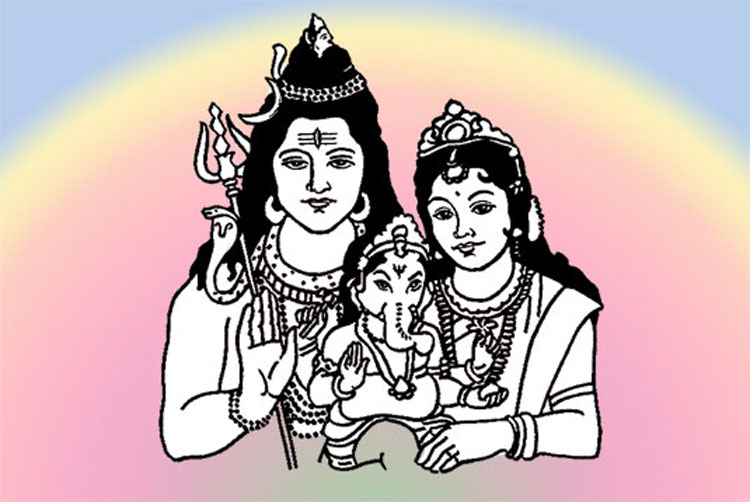
Shiva, Parvati, and Ganesha.
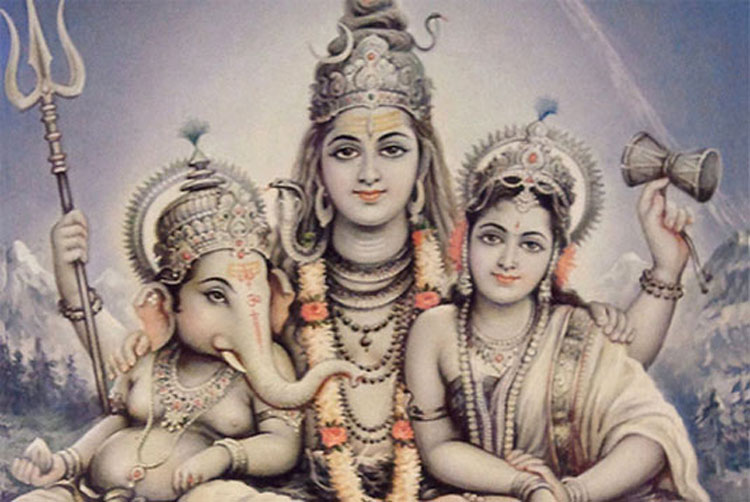
(Image source)
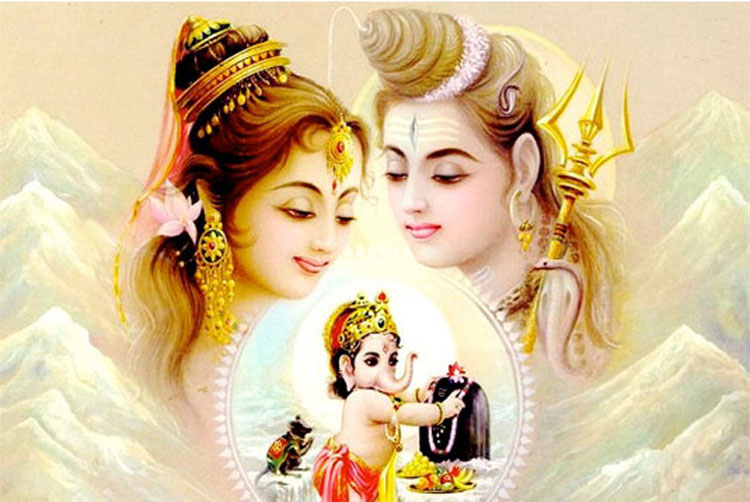
(Image source)
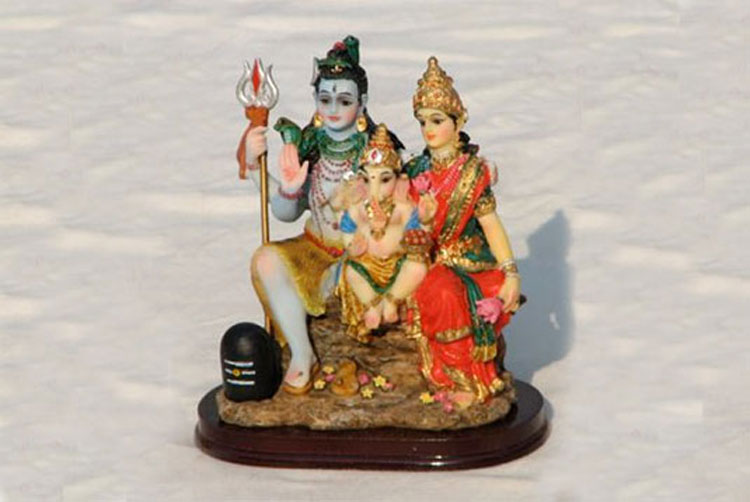
A plastic moulded idol of Shiva, Parvati, and Ganesha. (Image source)
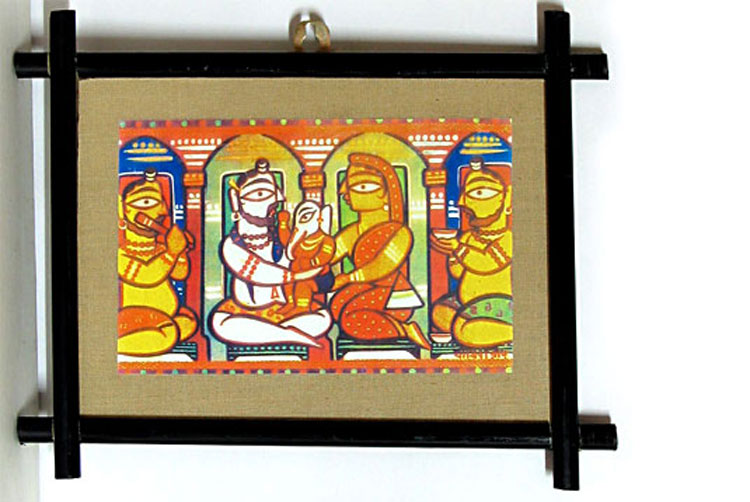
A Jamini Roy wall hanging of Shiva, Parvati, and Ganesha. (Image source)
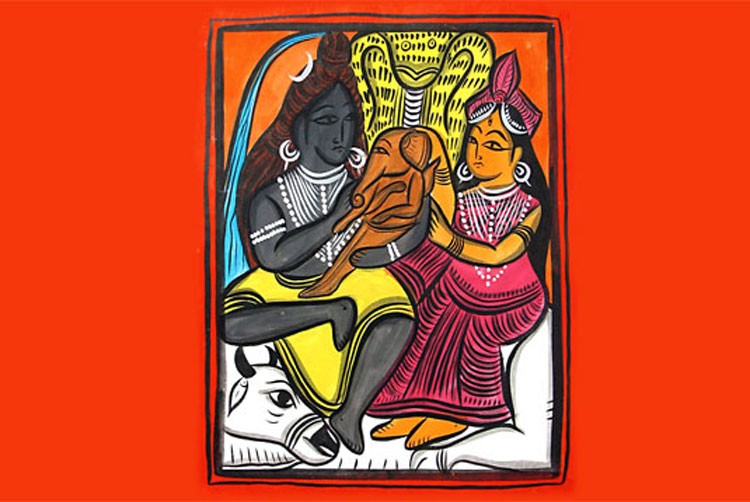
A Kalighat painting of Shiva, Parvati, and Ganesha. (Image source)
Ganesh Symbolism:
The portrayal of Lord Ganesha as one having a human body with an elephant head symbolizes the ideals of perfection as conceived by Hindu sages. Various profound philosophical concepts have been attributed to each part of Ganesha’s majestic figure by believers.
The image of Ganesha presented below depicts the significance and importance of each part of God.
An understanding of what man gleans from each part of Ganesha is briefly presented below.
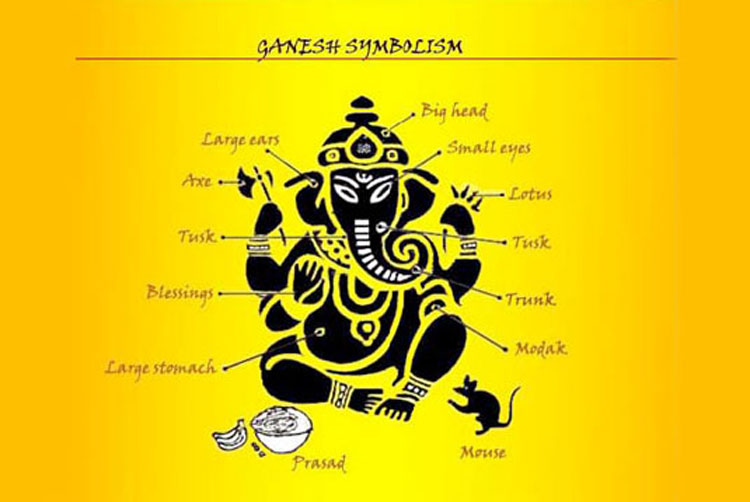
The elephant head: The elephant head is the symbol of material reality. It represents prosperity and power. The big head of an elephant also symbolizes wisdom, understanding, and a discriminating intellect that one must possess to attain perfection in life. There is also the belief that Ganesha's head symbolizes the Atman or the soul, which is the ultimate supreme reality of human existence.
The human body: There is the belief that Ganesha’s human body signifies Maya or the earthly existence of human beings. Lord Shiva by creating a boy who is half human and half animal draws the attention of the devotee to their animal as well as the human side. The fundamental difference between humans and animals is the intellectual capacity. Ganesha’s body draws the attention of the humans to this so they can outgrow their animal needs and fears, and evolve to realize their true potential.
The small mouth: The small mouth of Ganesha indicates that one must spend less time talking and utilize one’s energies for thinking or doing.
Large ears: Ganesha’s large ears signify that a perfect person is one who possesses a great capacity to listen to others and assimilate ideas.
The trunk: Ganesha has an elephant's trunk which symbolizes a large operating range in terms of functionality. It has the dexterity to uproot a tree and also lift a needle off the ground with equal ease. Likewise, it signifies that the human mind must be adaptable and efficient. It must be strong enough to face the ups and downs of the external world and also be perceptive enough to explore the subtle realms of the inner world. The mouse sitting near the feet of Ganesha: Ganesha is called Vakratunda, one whose trunk is turned to one side, either left or right. When the trunk points to the left it is closer to the heart and it indicates worldly form of Ganesha; this is the form that is kept inside the house. When the trunk points to the right it is away from the heart and it indicates a more ascetic form of Ganesha; this is usually kept outside the house, in temples.
The two tusks with the left tusk broken: The two tusks denote the two aspects of the human personality, wisdom and emotion. The right tusk represents wisdom and the left tusk represents emotion. The broken left tusk conveys the idea that one must always retain the good and throw away the bad. It is believed that the broken tusk served as a stylus which enabled Ganesha to write the epic Mahabharata for Sage Vyasa. The side with one tusk represents the spiritual reality and the side with the broken tusk represents the material reality.
Small eyes: The small eyes of Ganesha signify that one must have single-minded concentration and focus on anything one does.
The four arms: The four arms indicate that the Ganesha is omnipresent and omnipotent. The left side of the body symbolizes emotion and the right side symbolizes reason.
The axe and the noose: Ganesha holds an axe in the upper left hand and a noose in the upper right hand. The axe signifies that, in order to attain spiritual perfection, one should cut worldly attachments and conquer emotions. It is also a symbol of analysis or disintegration.
The noose or pasha in Ganesha's left hand is a gentle implement to capture all difficulties. The noose is a symbol of synthesis or reintegration.
The axe and the noose together represent the two abilities of the human mind to understand material reality and hence turn towards spiritual reality.
The lotus: Ganesha is often seen holding a lotus in his hand. The lotus signifies that one must live in the world without being affected by earthly temptations, just as a lotus, though growing in water remains unaffected by it.
The goad: Sometimes Ganesha is seen holding an elephant goad or Ankusha. This is a reminder that within all of us is animal power waiting to be encouraged and the same needs to be restrained too, that is, there needs to be a balance in life to achieve happiness. There is also the belief that the goad Ganesha propels mankind forward towards the eternal path and removes obstacles that come in the way.
The Modak: It is believed that Ganesha is very fond of this sweet steamed dumpling called the “Modak”. It is made of rice flour dough that is shaped like a small bag which contains a mixture of jaggery, coconut and sesame seeds. The shape of the Modak resembles a bag of money which is a symbol of wealth. It is believed that the Modak is shaped like an upward-pointing triangle which in Tantric art represents spiritual reality. Thus the Modak has the aesthetics of material reality but the geometry of spiritual reality.
The Prasad: The Prasad near the feet of Ganesha denotes that the whole world is at his feet and that he bestows wealth and prosperity upon his devotees. A variety of fruits associated with wealth and prosperity are offered to Ganesha as Prasad too; such as banana, coconut, sugar cane, wood apple, and rose apple.
Blessings: The lower right hand is shown in a blessing pose, which signifies that Ganesha always blesses his devotees.
The large stomach: The large stomach signifies that a perfect individual must have a large capacity to face all pleasant and unpleasant experiences of the world. In material terms, Ganesha’s large stomach indicates success with the least effort and also affluence. A snake is seen wrapped around Ganesha’s stomach which symbolizes retention and regeneration.
The mouse sitting near the feet of Ganesha: The mouse is the vehicle of Ganesha. In South India, it is believed that the mouse was once a demon that was defeated and domesticated by Ganesha. The mouse symbolizes the ego- a problem that can eat away all that is good in a person. Ganesha is the provider of solutions and helps in conquering the ego, so wisdom can shine forth in anyone.
Ganesha’s clothes: There is a symbolism associated with the colours used for Ganesha’s clothes. Ganesha is usually portrayed wearing red and yellow clothes. Yellow symbolizes purity, peace and truthfulness. This also indicates the qualities a perfect person must possess to perform all duties well in this world. The red colour that Ganesha is associated with represents Shakti, indicating that he is fiery and energetic. The colour red represents material reality in Hinduism.
It is an entirely different matter that the Ganesh idols that are commercially produced nowadays for the festival Ganesh Chaturthi or for other purposes come in various forms, postures adorned in multiple colours and accessories. There is a visible creative explosion in terms of exploration of this beloved God that will be discussed elsewhere in this resource in detail.

